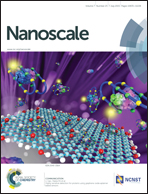Aqueous synthesis of PEGylated copper sulfide nanoparticles for photoacoustic imaging of tumors†
Abstract
By integrating high imaging sensitivity and high resolution in a single modality, photoacoustic (PA) imaging emerges as a promising diagnostic tool for clinical applications. Benefiting from the absorption in the near-infrared region (NIR), copper sulfide nanoparticles (NPs) as a contrast agent are potentially useful for increasing the sensitivity of PA imaging. However, the aqueous synthesis of size-tunable, biocompatible and colloidally stable copper sulfide NPs remains challenging due to the intrinsic dipole–dipole interactions among particles. In this work, aqueous synthesis of PEGylated copper sulfide NPs with controllable size between 3 and 7 nm was developed. The particle size-dependent contrast enhancement effect of the copper sulfide NPs for PA imaging was carefully studied both in vitro and in vivo. Although the contrast enhancement effect of the copper sulfide NPs is proportional to particle size, the in vivo studies revealed that copper sulfide NPs smaller than 5 nm presented higher tumor imaging performance, especially at the tumor boundary site, which was further discussed in combination with the pharmacokinetic behaviors of differently sized particles.


 Please wait while we load your content...
Please wait while we load your content...